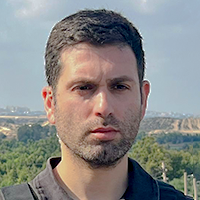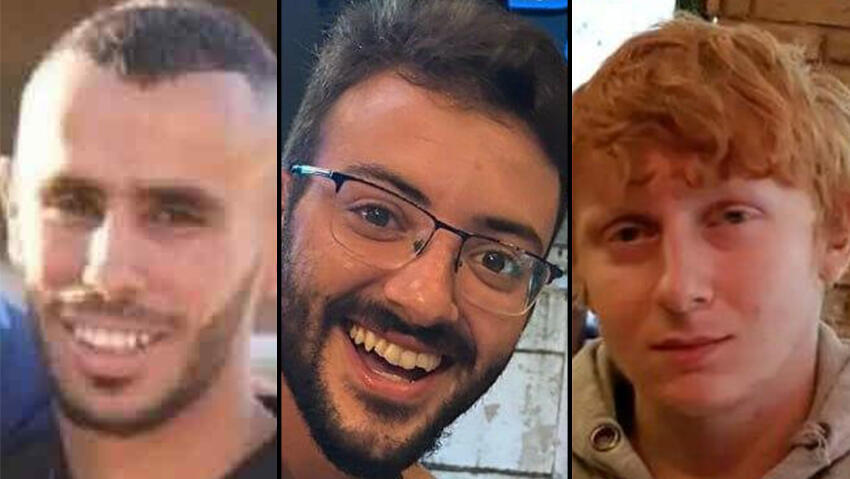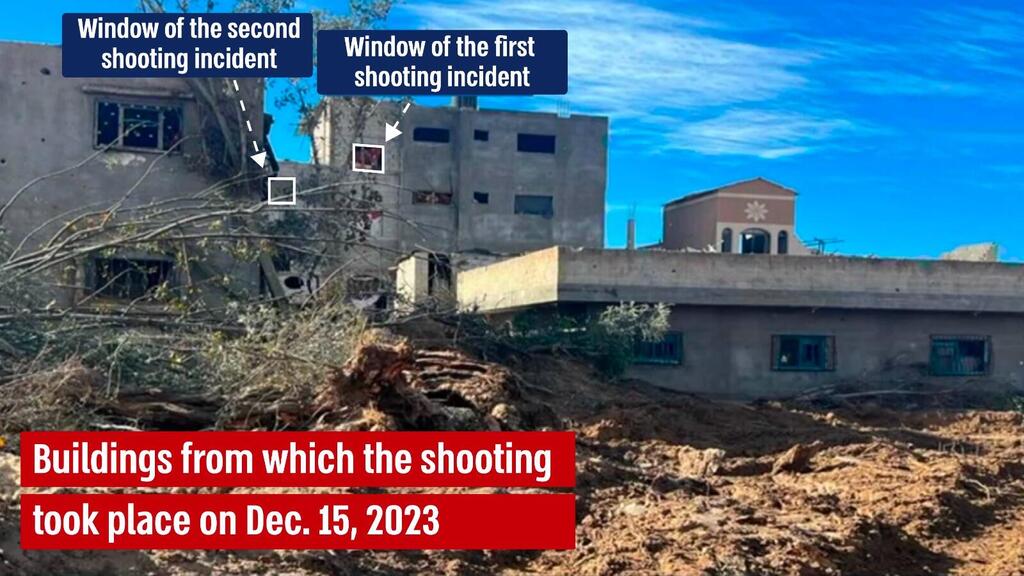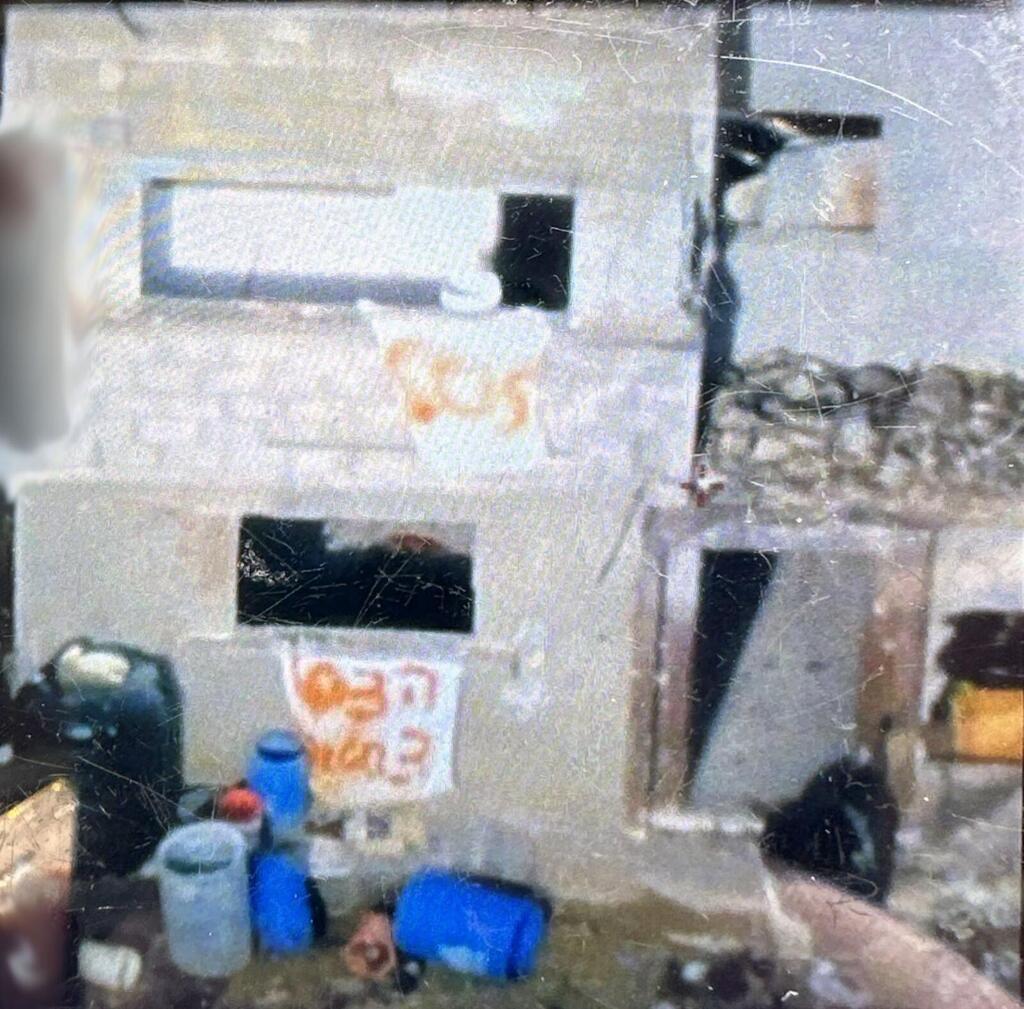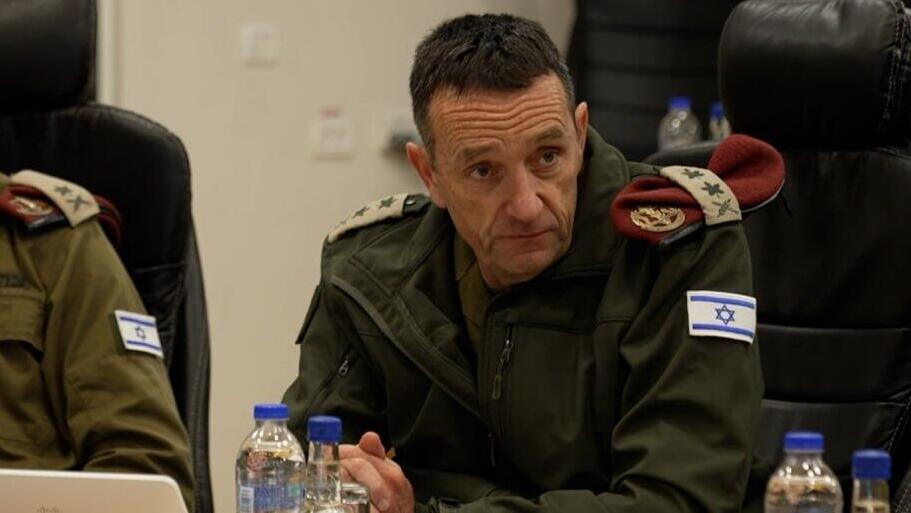The IDF has completed its investigation into the tragedy in the Gaza City neighborhood of Shijaiyah earlier this month which ended with the fatal shooting of three Israeli hostages – Alon Shamriz, Yotam Haim and Samer Talalka – by an IDF force that suspected them of being terrorists.
Read more:
Despite faults discovered at all levels, from the two maneuvering brigades involved that failed to share critical information, through the division above them and the Southern Command, up to the General Staff body established to address the hostages issue, Chief of General Staff Lt. Gen. Herzi Halevi decided to adopt the command echelons' recommendation and not to take any action against those involved, at least not until the end of the war.
The findings reveal that 40 yards and two buildings with an open, but narrow angle between them, separated the 17th Battalion sniper from the three hostages he identified in the nearby street. He spotted them at 9:42 a.m. on a sunny Friday morning with good visibility from a house where the force was stationed.
However, the investigation disclosed that a tall tree, its branches and leaves partially obstructing the view, stood between the sniper – equipped with a Trijicon sight – and the three abductees.
The three were moving in an area designated "red" for the soldiers securing the house with the force, where the battalion commander, Lt. Col. L., was also present. This area was off-limits to Gazan civilians, and anyone seen there was immediately suspected by the soldiers of being a hostile terrorist.
The sniper fired at the three, killing two of them, and the third managed to escape off to the side, likely toward a nearby building. At this point, the sniper shouted "Terrorists!" and the battalion commander stopped him, but he did not leave the building to pursue the suspect as initially assessed by the IDF.
The battalion commander was prepared for further action while two other soldiers in the building, armed with standard weapons and a Negev machine gun, spotted the third hostage from their window.
6 View gallery
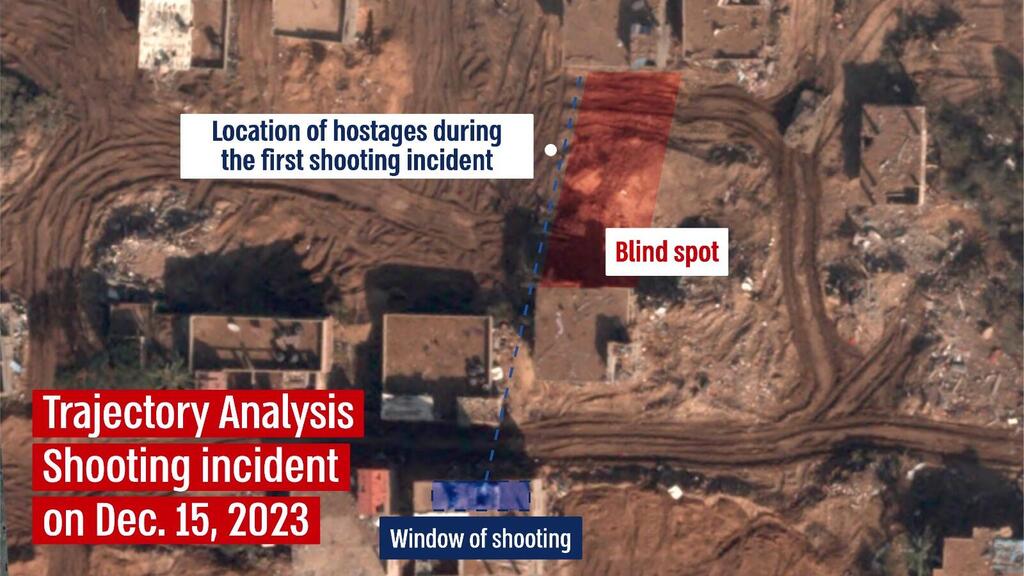

Aerial footage of the area where the shooting occurred
(Photo: IDF Spokesperson's Unit)
They fatally shot him, despite his shouts in Hebrew, including his name. The military suspects the soldiers didn't hear the commander's "cease fire" orders or the hostage's pleas for help in Hebrew. Only upon exiting for a sweep and noting his Western appearance did the force decide to verify the identity of the bodies.
The military noted in the investigation the lack of control over the force in the building, as the third hostage's death could have been prevented if the officers inside had understood that the three were unarmed and not an immediate threat.
It was only later revealed that the sniper who shot first had seen one of the hostages with a white flag but claimed it wasn't waved. The IDF's various visual sources, analyzed retrospectively, showed the three standing with the white flag at the point where the initial fire was opened for 20-30 seconds.
The tragedy began five days earlier when Golani soldiers killed the kidnappers without knowing their identity, a kilometer away as the crow flies from the site of the hostages’ fatal shooting.
Troops arrived to raid a building in the heart of Shijaiyah suspected of harboring terrorists. For operational reasons, around 5:00 a.m., the assault team decided first to enter an adjacent building, unaware that four terrorists holding three hostages were in the next building.
Initially, Golani soldiers sent an Oketz K9 dog equipped with a Go-Pro camera on its head to scout the two-story building. The dog startled the terrorists, who shot it in the middle of the staircase, killing it while the camera recorded the events. The soldiers then entered the building with live fire, eliminated the four terrorists – but did not completely clear the building, as the accompanying engineering force suspected it was booby-trapped.
As chaos ensued, the three hostages managed to escape shortly after the terrorists exchanged fire with the Golani soldiers and hurled grenades at them. Some soldiers heard cries of "help" in Hebrew but were convinced that the terrorists were shouting this as a deception tactic, similar to the cries of the third hostage five days later. After the Golani soldiers exited the building, they requested an Apache helicopter strike the house with several missiles, which apparently did not hit the hostages.
However, no one noticed in the dense, alley-filled area between 5:00 a.m. and 6:00 a.m., three unarmed, trauma-stricken figures crawling shirtless, hoping to reach freedom. Concurrently that day and nearby, another engineering unit found a paper note inscribed with "help" in Hebrew. The note was taken from the entrance of a tunnel – and no one in the IDF knew to connect it to the hostages or Golani’s encounter. Everyone assumed it was another Hamas deception.
The full investigation reveals that, for five days, the three hostages navigated the hostile neighborhood's combat zone, moving between several empty houses, sustaining themselves on food scraps and scarce water.
6 View gallery
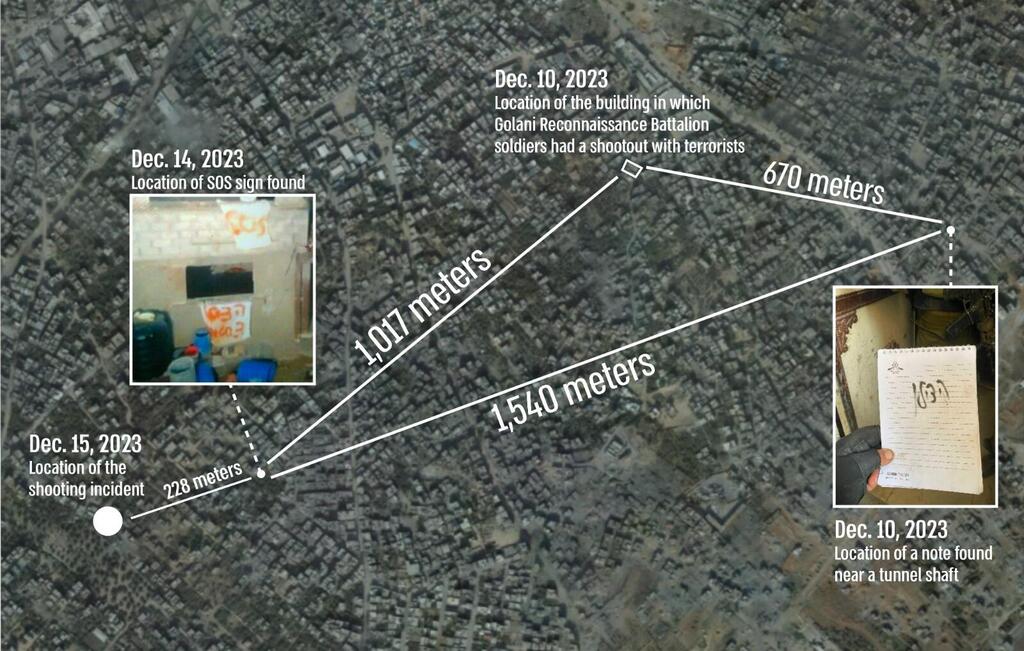

Aerial footage of the Shijaiyah area where the events detailed in the investigation occurred
(Photo: IDF Spokesperson's Unit)
"They acted heroically, with remarkable resourcefulness and dignity," commented officers exposed to the findings. At one point, they sheltered in a house and sprayed SOS and "help" on fabrics. On Thursday, a day before the three hostages were killed and after they had left the house, an IDF force located the signs they left on the front of the building but disregarded them, suspecting again that Hamas terrorists made the signs to lure them into a trap. The next day, the three were tragically killed by IDF fire.
Three days after that fateful morning, the IDF decided to return to the site of the Golani fire team’s clash in the center of the neighborhood to "clear the area" and retrieve the body of the dog.
The troops chose not to search the building at first for fear it was booby trapped. That stemmed from a deadly ambush the day before that left nine soldiers dead, including the commander of Golani's 13th Battalion, Lt. Col. Tomer Greenberg.
This event significantly occupied the forces in the area, so retrieving the dog and its Go-Pro camera, which captured the hostages’ cries in Hebrew during the fight with the terrorists, was given low priority. Their voices were clearly heard on the recording, but tragically, it was too late.
Additional faults were revealed in the full investigation: The command echelon operating in Shijaiyah was aware that there were likely hostages in the large, hostile neighborhood where some 900 terrorists were eliminated over roughly two and a half weeks of close-quarters combat, suicide bomber attacks and more.
Despite this, commanders did not convey this information to the frontline soldiers nor instruct them on what to do if they encountered or suspected they saw hostages or unarmed individuals while scanning targets or securing buildings.
Chief of Staff Herzi Halevi noted that troops responded well relative to what they saw and believed they were seeing in real-time. However, they should have acted differently in response to the Hebrew shouts, simply waiting another second and shouting a question in Hebrew, which would have prompted the hostages to respond in Hebrew – thereby making it clear to the soldiers that it wasn't a deception.
Another deficiency was found in the handling of the SOS signs found a day before the disaster; the information and photographs were passed to the relevant division but were dismissed after review.
"The orders given after the sniper's fire were not good, but they were given amid the noise and chaos of nearby moving tanks," the military stated.
"The soldiers did not act with malice, but the chief of staff, after speaking with the families, determined that the event's outcomes could have been prevented," the military added.
"Some soldiers were wearing earplugs after long days of intense combat in a threatening environment. We don't usually investigate extraordinary events during combat, nor do we pull commanders and soldiers engaged in fighting for inquiries, but here there was an urgent and vital need to do so to prevent such events from recurring in other sectors of the Strip."
According to Halevi's summary, "This was a grave incident with very serious outcomes. The IDF failed in its mission to rescue the hostages in this event. The entire chain of command feels responsible for this severe incident, regrets the outcome and shares the sorrow of the three hostages' families.
“The chief of general staff determined that the harm to the hostages could have been prevented. However, he clarified that there was no malice in the incident, and the soldiers acted correctly according to their understanding of the situation at that moment."
The chief of staff determined that "there is utmost importance in adhering to the rules of engagement. In situations where there is no immediate threat and the identification is not clearly an enemy, there needs to be a moment of assessment before firing, given the opportunity. This action is necessary to prevent, among other things, incidents of friendly fire.
“In this case, the hostages were not acting threateningly and were holding a white flag, so it would have been right to confirm their identification before firing. The pressure and the challenging operational environment made it difficult for the soldiers to implement these emphases."
He concluded by saying: "The shooting at the hostages should not have occurred – it did not align with the risk and the situation. However, it was carried out under complex circumstances and intense combat conditions under prolonged threat.
“We, the commanders, must ensure that operational instructions are clear and that the forces' actions on the ground consider additional aspects, reflecting the soldiers' and commanders' judgment in the field. Rules of engagement are essential and are meant to protect us, also to prevent us from causing harm to our own. They dictate and influence crucial decisions, as happened in this event."
The chief of staff focused on the necessary lessons relating to the connection between the intelligence-operational command led by Major General (res.) Nitzan Alon for the retrieval of the hostages, the Southern Command, and the divisions in the field.
He emphasized the importance of improving communication, transferring information from the command to the forces, and reporting any suspicious signs of the presence of hostages from the field to the command. He instructed all commanders to learn from the incident's lessons and immediately pass them on to the combat forces to prevent the recurrence of similar cases as much as possible. Additionally, he directed an increase in the forces' awareness in the field of hostages' presence in the combat zone, including their locations, photos and various findings about them.
The findings were presented to the families of the hostages. Alon Shamriz's father, Avi, after viewing the IDF's investigation at Camp Glilot, stated: "I watched the investigation the army conducted and presented to us, and what we deserve is recognition of my son as a fallen IDF soldier, and also to award him the Chief of General Staff's Commendation. It was very hard for us with what we saw, we will continue to learn more details."



